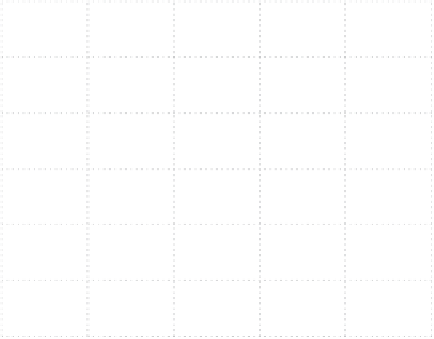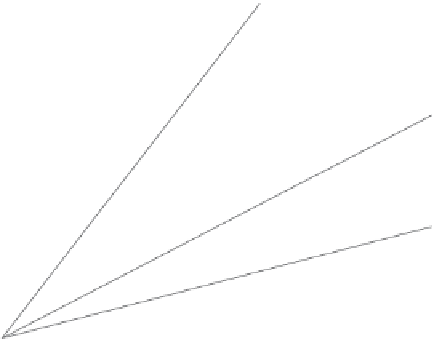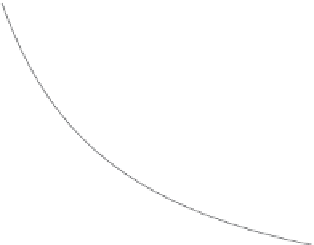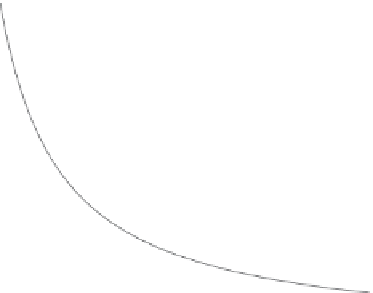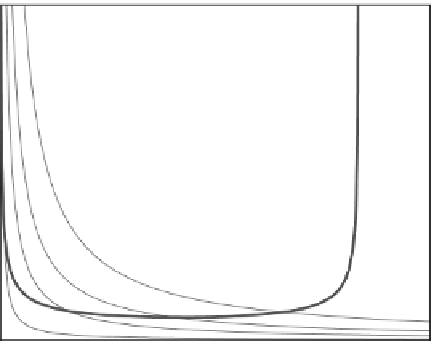Geoscience Reference
In-Depth Information
300
300
250
250
200
200
Ro
=
0.1
Ω
=100
150
150
Ω =50
100
100
Ro
=
0.25
Ω
=20
Ω
=10
50
50
Ro
=
0.5
Ω =5
Ro
=
1
Ω
=1
0
0
0
10
20
30
40
50
0
0.2
0.4
0.6
0.8
1
1.2
Ω
Ro
Figure 4.4.
Stability diagram for RPCF in the
Re plane (left) and RoRe plane (right). The thick line is the neutral stability curve,
and the thin lines show constant values of Ro and
, respectively. Note that the flow is linearly stable for Ro
>
1.
we comment on the implications for experiments of model
systems in the age of large-scale computations.
4.2. FLOW PARAMETERS AND FEATURES
OF SOME ROTATING FLOWS
4.2.1. Rotating Plane Couette Flow
Rotating plane Couette flow (RPCF) consists of a
two-dimensional Couette flow channel with two walls at
y
=
b
, with flow in the
x
direction and rotation along
the
z
axis (
z
). In principle, this flow is determined by
two control parameters, namely the Reynolds number and
a suitably defined nondimensional parameter that reflects
the rotation rate. Here the Reynolds number Re is conve-
niently defined using half the velocity difference between
the walls (
U
w
) and half the channel width (
b
). In the
engineering literature, the rotation is usually given as a
rotation number Ro =
z
b/U
w
, but from an experimental
point of view, it is more convenient to use the nondimen-
sional rotation rate
defined as
=2
z
b
2
/ν
since then it
is possible to change Re by varying
U
w
without affecting
. However, these parameters are, of course, connected
through the relation Ro =
/
Re. In the geophysical lit-
erature, the preferred nondimensional rotation parameter
is the Rossby number, which is the inverse of the rotation
number. In this chapter, we use the definitions of Ro and
given above since these definitions are used in much of
the laboratory work on these flows.
The RPCF is characterized by a large number of dif-
ferent flow states, which have been explored by
Tsukahara
et al.
[2010a]. For anticyclonic rotation, the minimum
Reynolds number for instability given by linear stability
theory is Re = 20.6 at a rotation number of Ro = 0.5 or
±
Figure 4.5.
Flow visualization using reflective flakes of 2D roll
cells in RPCF at Re = 50 and
= 2.6 obtained by
Tsukahara
et al.
[2010a]. Mean flow is in the horizontal direction and
the length and width of the photograph is approximately 60
h
and 30
h
, respectively. Copyright © Cambridge University Press,
2011. Reprinted with permission.
= 10.3. in fact, it is possible to write the neutral
stability curve in analytical form as Re
crit
=
+ 107
−
1
.
Figures 4.4a,b show the neutral stability curve in the
Re
plane and RoRe plane together with the corresponding
lines for some constant values of Ro and
, respectively.
The primary linear instability takes the form of stream-
wise independent roll cells (see Figure 4.5) that reach
across the channel with a spanwise size close to the chan-
nel width (i.e., 2
b
), giving them a cross-sectional aspect
ratio close to 1. For higher values of
and Re, the roll
cells develop into more complicated three-dimensional
nonstationary types. An interesting feature is the three-
dimensional nonlinear
steady
states that were theoretically
predicted by
Nagata
[1998] and also observed in exper-
iments by
Hiwatashi et al.
[2007], and
Tsukahara et al.


